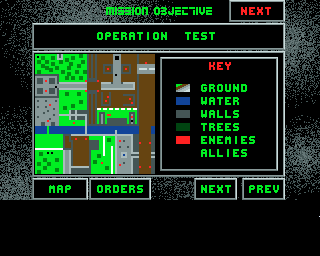Some of the releases of Task Force have fragments of deleted files toward the end of the disk, which can be recovered using a tool like DiskSalv. They consist of earlier versions of some of the game’s source code and files.
File list
The following files can be recovered. On some distributions, such as compilations and the CU Amiga coverdisk, these are not available.
MISSION1
ST-PTPlay.s
TF-Armour.gfx
TF-Instructs.s
TF-Key.gfx
TF-Main.s
TF-Masktiles.gfx
TF-Masktiles2.gfx
TF-Panel2.gfx
TF-Paneledge.gfx
TF-Panelweps.gfx
TF-Tiles.gfx
mod.ingame
There are two slight variants in distribution. The PD Soft release and 17 Bit
Software release both have TF-Panelweps.gfx recoverable, but not MISSION1.
One other version found on TOSEC has MISSION1 but not TF-Panelweps.gfx.
What I suspect happened is that, like some of his other games (including The Challenge of the Matrix, Spectrum, One on One, Arazmax, Roton, Turbo Thrust, Firefly, and Overlander), the author originally included the source code on the disk. However, with the inclusion of the intro, it would no longer fit, and the source had to be deleted from the disk.
Without the intro or the intro music file, the game takes up 304 KB and its source takes up 448 KB, a total of 752 KB, which would fit on an 880 KB disk with about 128 KB to spare. However, the intro is 208 KB, so its inclusion would have made it necessary to delete the source code from the disk, leaving recoverable fragments behind.
Differences with final version
In nearly all cases the files are identical to those in the officially released
source code, meaning that the final game would be the same. The only differences
are the files MISSION1, TF-Main.s, and TF-Instructs.s.
TF-Main.s is the assembly source code file which covers most of the main
program. TF-Instructs.s is the code for the Instructions pages. They are
mostly the same as finished release, suggesting the game was nearly complete at
this point, but there are a few differences.
TF-Instructs.s
In the early Instructions file, the credits have not been added for the game’s intro, suggesting that it was added late in the game. It credits Steve Packer for the intro and the game’s main developer Mark Sheeky for the intro music.
Instructions are also added for the keyboard controls: M to toggle the map
during play (a good usability improvement), and S to toggle the music. The
total Instructions pagecount number is increased to from 30 to 32 to account for
the changes.
A reference to the missiongfx suggests that the file TF-Missionscreen.pack
increased in filesize, from 9,357 bytes in the old version to 9,691 in the final
version. It’s a rudimentary compression method for files beginning with the
magic numbers SC01, a reference no doubt to developer Scorpius.
TF-Main.s
The first change between the old version of this file and the final version is several lines of code handling the Map toggle and Music toggle keys. The added functions are for clearing the main play area, drawing the map, and printing the soldiers’ locations on the map.
In the finished version, a delay of 40 is added after a non-explosive weapon is
fired. Normally, a delay of 30 is added after moving or firing; this 40 delay is
in addition to that. The delay function works by checking $DFF004, VPOSR, or
the Amiga’s CRT vertical beam position, meaning that the function is based on
the fixed screen refresh rate instead of CPU speed. A comment notes that this is
the coder’s third version of the function, and was designed for that reason;
presumably earlier versions were CPU-based delays which ran more quickly on
faster Amigas.
The other difference is the addition of key inputs for the map and music toggle functions, which are defined separately in both move phase and fire phase. The fire phase was incorrectly commented “keyboard equivs for move phase” in the old version, probably due to copy-pasted code, but this comment was fixed in the final version.
MISSION1
MISSION1 is an old or test variant of Mission1. The map layout is identical
to Operation Spring. The mission title is changed to Operation Test, and the
description is blank.
The other difference is that three of the five soldiers start in different locations.

Operation Test
Two appear in the usual position at the bottom-left of the map behind the fence. One is at the very top-left of the map, perhaps to test edge detection. One is down and right a little from that, at the entrance to the the fortified area with two enemies. The other is near the helipad at the top of the map, perhaps to test leaving the map. The one in the middle of the map is the hostage.
« Back to index page